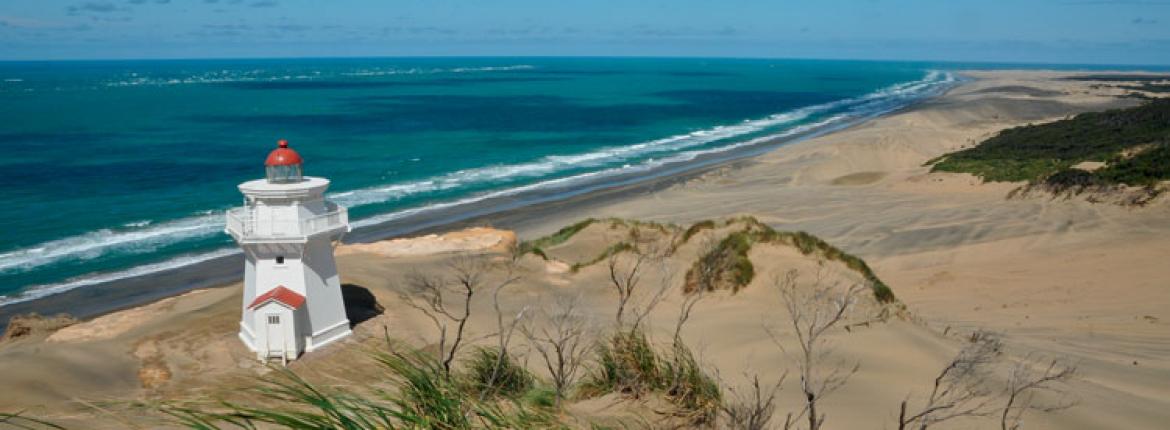It’s an impressive surprise. The Dargaville Museum has a collection of 120 piano accordions. This is because a local, Kevin Friedrich, became an internationally-renowned accordion player and, though he now lives in New York, he buys accordions from all over the world for this collection. Besides accordions, the museum specialises in kauri gum.
Dargaville’s first fortunes were built on the finding and trading of it. But kumara is now the gold of the northern Kaipara and Ernie and Mavis Suckling are the biggest producers in New Zealand, growing 300 tonnes a year. That’s enough to fill a shed 53m long and 10m wide, stacked to the roof.
Ernie, lovingly stroking a dusky red four-kilogram monster, says, “Man can live on kumara alone. It’s a full food, healthy and mineral-rich.”
His love for this sweet tuber is such that Ernie has built The Kumara Box at one end of the shed, where visitors can learn about the crop before taking a tour of the farm on Ernie’s kumara train: two-seater trailers hooked together and pulled along by a tractor.
No other place on earth grows kumara as well as this; that’s because of mild winters and the moist, rich, alluvial soil from Big Muddy – an affectionate name for the Wairoa River, the northern arm of the Kaipara Harbour. Some of Big Muddy’s greatest admirers live in Te Kopuru, a pretty town straggling along its edge.
It’s impossible to miss the fabulous flotsam and jetsam garden created by Leon and Lorraine Searle who have been walking the beaches for 45 years collecting trash and treasure. Treasure includes whale bones, fishing nets, fishing floats galore and, once, a Met Service weather buoy still beeping. Most of their gatherings are trash, which is recycled or sent to the tip, but the best bits decorate their garden.
At Te Kopuru we turn west and leave the quiet Kaipara for the west coast. Glinks Gully is only a few kilometres away but is a different world where the northwest wind is raging and layers of huge waves roll into the beach in an endless, mesmerising sequence. We reverse our big motorhome into a sheltered corner of the campground to escape the wind.
The beach, from Maunganui Bluff around the Kaipara Heads to Pouto Point, is New Zealand’s longest beach road and its 100kms can be driven. It has road signs, indicating speed restrictions. It’s tempting but absolutely not in our hired Britz; insurance does not stretch to beach roads.
I learnt, in Dargaville museum, that 157 sailing ships were wrecked on this coast and their skeletons lie under the sand. Often, after a storm, when masses of sand is moved, wrecks reappear and folk sometimes find real treasure, such as a 200-year-old anchor or a fat brass cannon.
By morning the wind has gone, the day is blue and the giant waves are more orderly. We trundle south on sealed road through green farmland and past occasional pine forests. There are glimpses of Big Muddy from hilltops and little country hamlets with a church, school and a couple of houses. The campervan handles the gravel road of the last 19kms well. At Pouto campground we park near where the hill drops away to the Kaipara Harbour so we can sit in our roaming home and have dinner enjoying vast views of water and sky.
The river has dropped its silt and is now blue. The beach road, the one we didn’t go on, ends here and at the entrance to it a silver Mercedes is stuck in sand. There is enormous drama with ropes and tows and a 4X4, revving and wheel spinning, and the Merc’ is ignobly pulled out backwards. We want, we really want, to visit Pouto lighthouse but are too lazy to walk the seven kilometres there and back and dare not take the Britz along the sand.
Jock Wills, of Pouto Sand Safaris, solves the problem. Jock, 76-going-on-16, has a special sand-friendly dune buggy and he zooms down the beach, stopping periodically to tell us stories, look at a car that got stuck five days ago and now has sand up to the windows, to admire a seal and to thrillingly zip up and down a few rollercoaster-style sand tracks.
The lighthouse was built in 1842 to guide sailing ships across the Kaipara’s treacherous bar. Now there is no gum or kauri logs to trade and kumara goes south by truck. The few boats that enter the harbour do so with the help of GPS and echo-sounders, so the lighthouse is a historic place and the light is in Dargaville Museum. It’s still a thing of beauty: tall and elegant, bright white with a cute porch and a red dome. It’s a memorial to a more adventurous past and an exclamation mark at the end of an interesting, but seldom travelled, peninsula.
Reported by Liz Light for our AA Directions Spring 2024 issue








